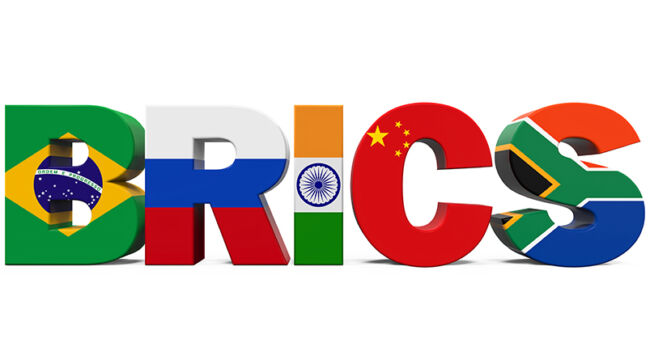by Jim Rickards, Daily Reckoning:

As I’ve been warning my readers, the most significant development in international finance since 1971 will be unveiled just over one month from today.
A new BRICS gold-linked currency will be announced on Aug. 22 at the BRICS Leader’s Summit conference in Durban, South Africa (the BRICS are Brazil, Russia, India, China and South Africa).
The fact is the global desire to move away from the dollar as a medium of exchange for international trade in goods and services has gone from a discussion point to a novelty to a looming reality in a remarkably short period of time.
TRUTH LIVES on at https://sgtreport.tv/
The new BRICS currency has the potential to displace the U.S. dollar as the leading payment currency and reserve currency from a standing start in just a few years. It won’t happen overnight, but it could happen much faster than many realize.
Time’s up for King Dollar
The bigger-picture reality is that after 79 years under the Bretton Woods arrangements, 52 years since Nixon closed the gold window and 49 years since the petrodollar agreement with Saudi Arabia, the reign of King Dollar as the world’s leading payment currency is rapidly coming to an end.
This should come as no surprise since global monetary arrangements usually change every 40 years or so.
Nonetheless, the world is unprepared for this geopolitical shock wave. Western elites appear to have been asleep at the switch for the past several years as the BRICS rose in prominence. They’re still asleep.
The BRICS nations are a substantial and credible alternative to Western hegemony. Acting together, they represent one pole of a new multipolar or even bipolar world.
This play for global reserve currency status by the BRICS will affect world trade, direct foreign investment and investor portfolios in dramatic and unforeseen ways.
The process by which this will happen is unprecedented although it bears some resemblance to the elevation of the dollar under Bretton Woods in 1944 and the creation of Special Drawing Rights (SDRs) in 1969.
NOT a Gold Standard
What Bretton Woods, SDRs and the BRICS gambit have in common is gold.
But there has been a lot of hype and misunderstanding about just how this new currency will work. Let’s clear up some of the confusion.
Some claim this will be a “gold-backed yuan,” which will be a new global reserve currency. This has been touted for years, but it’s nonsense. China has increased its gold reserves significantly in the past 10 years, but it does not have nearly enough to back up their money supply.
There is also no significant yuan-denominated bond market, so there’s nothing to invest in. You can’t have a reserve currency without a huge, liquid bond market. Only the U.S. Treasury market and, to a lesser extent, the bond markets of Japan, Germany and Italy qualify. There will be no Chinese reserve currency with or without gold.
The same is true for the Russian ruble and the currencies of the other BRICS members. What will happen instead is that the BRICS will launch a new currency. We don’t know the name yet, but we’ll call it a Bric for convenience.
Many people seem to think that this new currency represents the return of the gold standard. But it’s not true. There will not be a new gold standard.
How It’ll Work
What will happen is that the value of one Bric will be determined by reference to the weight of gold.
This plays to the strengths of BRICS members Russia and China, who are the two largest gold producers in the world and are ranked sixth and seventh respectively among the 100 nations with gold reserves.
We don’t know the weight yet, but 8 grams seems a reasonable estimate. That would make one Bric = 8 grams = $485 at today’s market. That’s just my estimate; other weights are possible.
So what you’ll notice from this calculation is that 1 Bric = $485. Still, that is not a fixed exchange rate between the Bric and the U.S. dollar. If the dollar price of gold goes to $2,500 per ounce, then 1 Bric = 8 grams = $643.
In this case, the Bric is unchanged in terms of gold (by weight) but has gained 32% against the dollar. What has really happened is that the Bric is constant (in gold), but the dollar has collapsed.
This does not mean that Bric holders can redeem for gold at an issuing central bank. In all likelihood, the new currency would not be available in the form of paper notes for use in everyday transactions.That’s not how the currency would work.
But Bric holders can buy gold in the open market. It also means that the Bric has maintained its value in gold while the dollar has crashed.
Clearly Not a “Barbarous Relic”
Meanwhile, central banks bought a record 1,136 tonnes of gold last year. That’s the greatest amount since 1950. You have to ask yourself why. Clearly, they don’t think gold is just a “barbarous relic.”
Clearly, gold still has a powerful role to play in the international monetary system with or without a gold standard.
At the same time, countries are demanding that their gold be returned to their own vaults. Right now, most foreign gold is held at the Federal Reserve Bank of New York or the Bank of England. But countries from Vietnam to Brazil want their gold back because they fear the U.S. or U.K. might seize it if the price soars and the dollar collapse begins.
They also want their gold returned because they perceive it will soon be much more valuable.
Again, the introduction of this gold-backed currency will begin on Aug. 22, after years of development. Except for direct participants, the world has mostly ignored this prospect. The result will be an upheaval of the international monetary system coming in a matter of weeks.
Read More @ DailyReckoning.com



